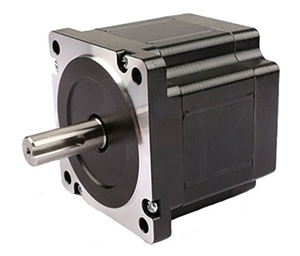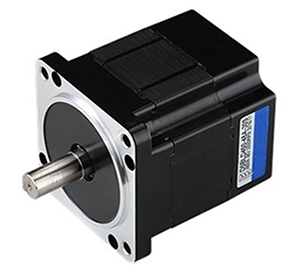Brushless DC Motor vs. Stepper Motor
Mon, Jan 25 by ATO.com
What is the brushless DC motor/ stepper motor?
Brushless DC motor
- The brushless DC motor is composed of a motor body and a brushless motor driver. It is a typical mechatronics product. Because the brushless DC motor runs in a self-control mode, it will not add a start winding to the rotor like a synchronous motor started under heavy load under variable frequency speed regulation, nor will it cause oscillation and loss of step when the load changes suddenly. The permanent magnets of small and medium-capacity brushless DC motors now mostly use high magnetic energy level rare earth neodymium iron boron (Nd-Fe-B) materials.
Stepper motor
- A stepper motor is a motor that converts electrical pulse signals into corresponding angular or linear displacements. Every time a pulse signal is input, the rotor rotates an angle or moves forward. The output angular displacement or linear displacement is proportional to the number of input pulses, and the speed is proportional to the pulse frequency. Therefore, the stepper motor can be called the pulse motor.
Different Working Principle
BLDC motor
- The BLDC motor uses semiconductor switching devices to realize electronic commutation, that is, it uses electronic switching devices to replace traditional contact commutators and brushes. The brushless dc motor has the advantages of high reliability, no reversing sparks, low mechanical noise, etc., so it is widely used in high-end audio recorders, video recorders, electronic instruments and automated office equipment.
Stepper motor
- Nema stepper motor is based on the principle of electromagnets to convert electrical energy into mechanical energy. It is driven by coils wound on the slots of the motor stator. The biggest difference between a stepper motor and other control motors is that the stepper motor can receive digital control signals (electric pulse signals) and convert them into corresponding angular or linear displacements. It is actually an executive element that completes digital mode conversion. Moreover, it can be open-loop position control. Input a pulse signal to get a prescribed position increment. Compared with the traditional DC control system, such an incremental position control system hardly needs to be adjusted, and the cost is significantly reduced. The angular displacement of the stepper motor is strictly proportional to the number of input pulses, and it is synchronized with the pulse in time. Therefore, as long as the number of pulses, frequency and phase sequence of the motor windings are controlled, the required rotation angle, speed and direction can be obtained.
Different Structure
Brushless DC Motor
- The high speed bldc motor is composed of a permanent magnet rotor, a multi-pole winding stator and a position sensor. The position sensor commutation of the stator winding current in a certain sequence according to the change of the rotor position. (The position of the rotor poles relative to the stator winding is detected, and a position sensing signal is generated at the determined position. After being processed by the signal conversion circuit, it will control the power switch circuit and switch the winding current according to a certain logical relationship.) The working voltage of the stator winding is provided by the electronic switch circuit controlled by the position sensor output. The position transducer of the brushless DC motor has three types: Magnetic sensitive, photoelectric and electromagnetic.
- For a brushless DC motor using a magnetic-sensitive position sensor, the magnetic-sensitive sensor (such as the Hall element, magneto-sensitive diode, magneto-sensitive pole tube, magneto-sensitive resistor or application specific integrated circuit, etc.) is installed on the stator assembly to detect the change in the magnetic field generated when the permanent magnet and the rotor rotate.
- The BLDC motor adopting photoelectric position transducer is equipped with photoelectric sensor in a certain position on the stator assembly. A light shield is installed on the rotor, and the light source is a light-emitting diode or a small bulb. When the rotor rotates, the photosensitive components on the stator will generate pulse signals intermittently at a certain frequency due to the effect of the light shield.
- Brushless DC motors using electromagnetic position sensors are equipped with electromagnetic sensor components (such as coupling transformers, proximity switches, LC resonance circuits, etc.) on the stator assembly. When the position of the permanent magnet rotor changes, the electromagnetic effect will cause the electromagnetic sensor to generate a high-frequency modulation signal (the amplitude changes with the rotor position).
Stepper Motor
- Nema stepper motors are generally composed of front and rear end covers, bearings, central shafts, rotor cores, stator cores, stator components, corrugated washers, screws and other parts. The iron cores of the stator and the rotor are made of laminated silicon steel sheets. There are six magnetic poles on the stator, and each two opposite magnetic poles are wound with the same phase winding. The three-phase winding is connected in a star shape as the control winding. There are no windings on the rotor core, only four teeth. The tooth width is equal to the stator pole shoe width.
Different Classification
Brushless DC Motor
- If divided by working characteristics, brushless dc motors can be divided into two categories, one is a DC brushless motor with DC motor characteristics, and the other is a DC brushless motor with AC motor characteristics. Both are mostly powered by DC power sources. The difference is that the former uses a position sensor to detect the position of the rotor, and uses the detected signal to trigger the corresponding electronic commutation circuit to achieve contactless commutation. The latter converts direct current into alternating current through an inverter to drive a general asynchronous motor or a synchronous motor.
- If divided according to the driving mode, there is one category of the square wave BLDC motor. The back EMF of the motor body is designed as a trapezoidal wave. The inverter outputs a square wave current or voltage, and maintains an appropriate phase relationship with the motor back EMF, thereby generating a smoother electromagnetic torque.
- If divided according to the detection method of the rotor signal, the brushless motor can be divided into two categories: Position transducer and no position transducer. For the position transducer, due to some shortcomings of the sensor, such as susceptibility to temperature, dust, vibration and other working environments, the application of brushless DC motors is restricted. The no position transducer overcomes the shortcomings of sensors, so it is more widely used.
- Divided according to the shape of the magnet, the motors can be divided into two categories: Built-in and surface-attached. There are many different types in each category, which are basically similar to permanent magnet motors.
Stepper Motor
Stepper motors can be divided into three main types according to their structure: Reactive stepper motor, permanent magnet stepper motor and hybrid stepper motor.
- Reactive stepper motor
The reactive nema stepper motor has windings on the stator and the rotor is composed of soft magnetic materials. It has a simple structure, low cost, and a small step angle of up to 1.2°, but it has poor dynamic performance, low efficiency and high heat generation. Therefore, its reliability is difficult to guarantee. - Permanent magnet stepper motor
The rotor of the permanent magnet stepper motor is made of permanent magnet material. The number of poles of the rotor is the same as that of the stator. Its characteristics are good dynamic performance and large output torque. However, this kind of motor has poor accuracy and large step angle (generally 7.5° or 15°). - Hybrid stepper motor
Hybrid stepper motors combine the advantages of reactive stepper motor and permanent magnet stepper motor. The stator has multi-phase windings and the rotor adopts permanent magnet materials. There are many small teeth on the rotor and stator to improve step accuracy. Hybrid stepper motor’s characteristics are large output torque, good dynamic performance and small step angle. But the structure is complicated and the cost is relatively high.

